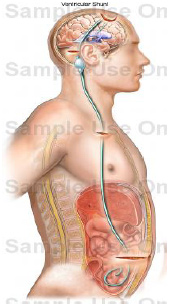What is a insertion of ventricular shunt?
- Peritoneal Shunt
- Pleural Shunt
- Atrial Shunt
This procedure is performed to relieve pressure inside the skull caused by fluid on the brain. This fluid is drained from the ventricles of the brain into the abdominal/pleural cavity or atrium by the means of a shunt. A shunt usually consists of two catheters and a one-way valve.
A small cut is made in the scalp and a small hole is drilled into the skull beneath the cut. A small tube (catheter) is placed into the brain to drain the fluid.
Another cut is made either in the abdomen or chest. A second catheter is tunnelled under the skin, from behind the ear, down the neck and chest, and ending a cavity.
The catheter from the abdomen and the catheter in the brain are then connected by a valve. This valve controls the flow of fluid from the brain.
The valve will be sutured to stop it from moving. The wounds will be closed with sutures.
My Anaesthetic
This procedure will require a General Anaesthetic.
See About your Anaesthetic information sheet for information about the anaesthetic and the risks involved. If you have any concerns, talk these over with your doctor.
If you have not been given an information sheet, please ask for one.
What are the risks of this specific procedure?
There are some risks/complications with this procedure.
Common risks include:
- Infection. This may need antibiotics and further treatment.
- Minor pain, bruising and/or infection from IV cannula site. This may require treatment with antibiotics.
- Bleeding. If bleeding occurs further surgery may be required. Bleeding is more common if you have been taking blood thinning drugs such as Warfarin, Asprin, Clopidogrel (Plavix or Iscover) or Dipyridamole (Persantin or Asasantin).
Uncommon risks include:
- The shunt may go into an unexpected position. This may require further surgery to re-position the shunt.
- The shunt may become infected. This may require removal of the shunt.
- The shunt may block, become disconnected or malfunction. This may require further surgery.
- Abnormal sensations from the wound. This may be temporary or permanent.
- Fluid leakage from around the brain can occur after the operation. This may require further surgery.
- Small areas of the lung may collapse, increasing the risk of chest infection. This may need antibiotics and physiotherapy.
- Increase risk in obese people of wound infection, chest infection, heart and lung complications, and thrombosis.
- Clots in the leg (deep vein thrombosis or DVT) with pain and swelling. Rarely part of this clot may break off and go into the lungs.
Extra specific risks of Pleural Shunt.
- Air in the lung (Pneumothorax). This would require further treatment.
- Collection of fluid within the lung. (Pleural effusion). This would require further treatment.
Extra specific risks of Atrial Shunt.
- Arrhythmias. This would require further treatment.
- Infection of the heart (Infective Carditis). This would require further treatment.
- Kidney infection (Glomerular nephritis). This would require further treatment.
Rare risks include:
- A heart attack because of the strain on the heart.
- Stroke or stroke like complications can occur which can cause weakness in the face, arms and legs. This could be temporary or permanent.
- Epilepsy which may require medication. This condition may be temporary or permanent.
- Injury to the liver, bowel, lung or heart due to the tunnelling process. This may require further surgery and an increase in hospital stay.
- Death is rare due to this procedure.


 Appointments
Appointments